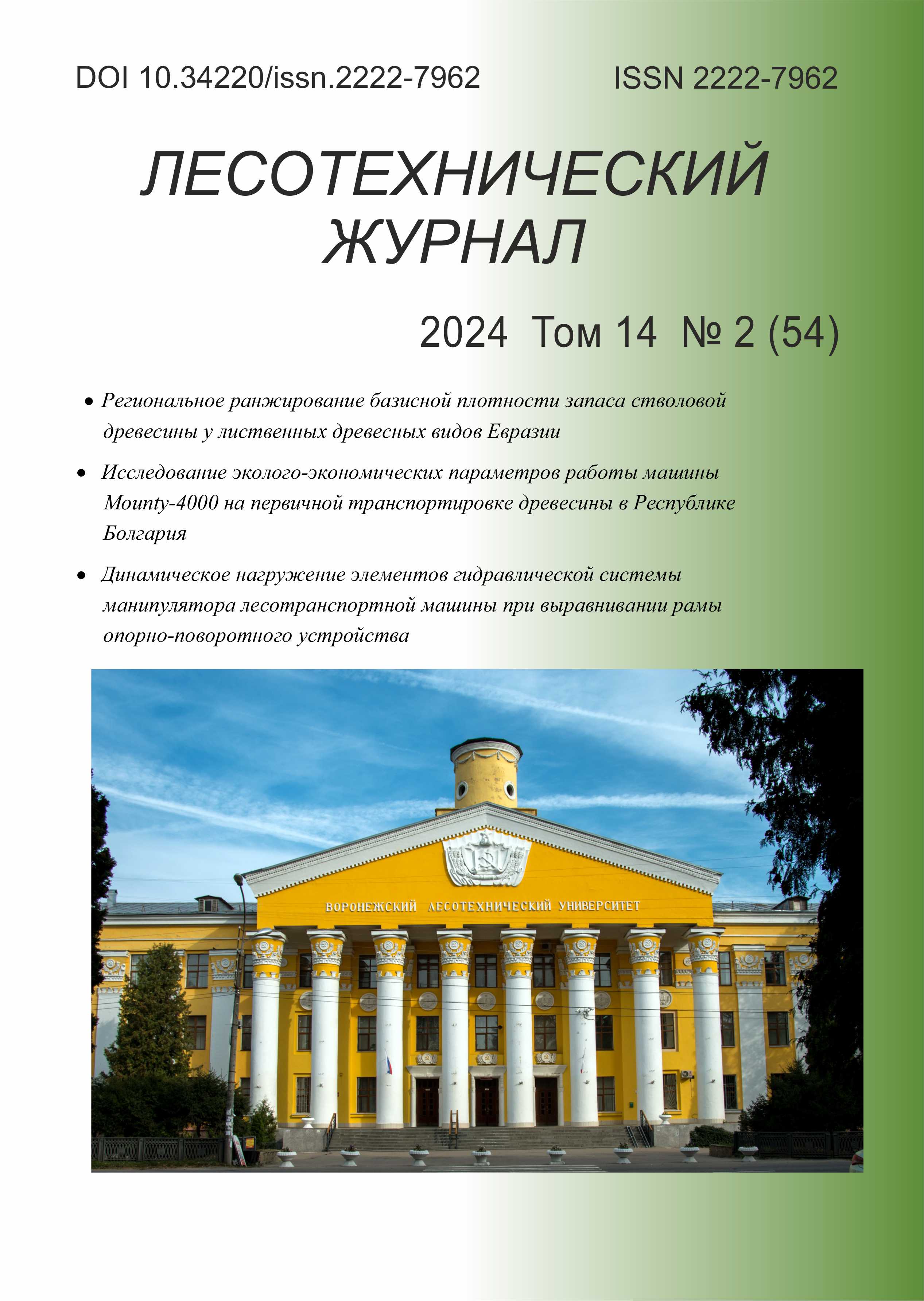Russian Federation
Voronezh, Russian Federation
Russian Federation
Voronezh, Voronezh, Russian Federation
UDC 630
The taiga forest landscapes of the Russian Federation, being the main part of the boreal forests of our planet, are currently undergoing intensive exploitation. Reforestation carried out after harvesting in such areas often includes tillage in the form of formation of layers, ridges or linear microhills due to the predominance of temporarily moistened or wetland soils. The effectiveness of the preparation of waterlogged soil by microhills directly depends on the structural and technological parameters of a forest plow combining plow bottom and spherical discs. A series of experiments on strain gauge sampling of a forest plow draught resistance of and the linear dimensions of the microhill formed by it were carried out in the soil channel. Regression models of the influence of plough design parameters and soil moisture are adequate to the experimental values of draught resistance (F = 13.847, p = 0.000334) and microhill height (F= 20.646, p = 0.000045). Based on the compiled models, a number of parameters of the forest plow structural elements were optimized using the Harrington desirability function. The optimal values of the approach angle and the angle of inclination of spherical disks, the distance from the center of their rotation to the edge of the plow bottom earthboard were determined, and the influence of humidity of the treated soil environment on the estimated output characteristics of the plow was estimated. The results obtained can be used in the implementation of research and development on the creation of modern forest tillage equipment.
boreal forests, reforestation, wetland soils, microhill, forest plow, design parameters, regression analysis, optimization
1. Semenov M. A., Komarova O. V. Ocenka uyazvimosti lesnogo hozyaystva lesostepnoy i stepnoy zon Evropeyskoy chasti Rossii k naibolee veroyatnym izmeneniyam klimata. Vestnik Voronezhskogo gosudarstvennogo universiteta. Seriya: Geografiya. Geoekologiya. 2022, 3: 76-85. DOI: https://10.17308/geo/1609-0683/2022/3/76-85.
2. Pronyaeva L. I., Pavlova A. V., Fedotenkova O. A. Razvitie lesnogo kompleksa strany: tendencii i perspektivy. Nacional'nye interesy: prioritety i bezopasnost'. 2020, 10(391): 1834-1856. DOI https://10.24891/ni.16.10.1834.
3. Gauthier S., Bernier P., Kuuluvainen T., Shvidenko A. Z., Schepaschenko D. G. Boreal forest health and global change. Science. 2015; 349(6250): 819-22.DOI: https://doihttps://doi.org/10.1126/science.aaa9092.
4. Il'incev A. S., Shamont'ev I. G., Tret'yakov S. V. Sovremennaya dinamika lesopol'zovaniya v boreal'nyh lesah Rossii (na primere Arhangel'skoy oblasti). Lesotehnicheskiy zhurnal. 2021, 3: 45-62. DOI: https://doi.org/10.34220/issn.2222-7962/2020.3/4.
5. Wei X., Giles-Hansen K., Spencer S., Ge X., Onuchin A., Li Q., Burenina T., Ilintsev A., Hou Y. Forest harvesting and hydrology in boreal Forests: Under an increased and cumulative disturbance context. Forest Ecology and Management. 2022, 522: 120468. DOI: https://10.1016/j.foreco.2022.120468.
6. Dymov A. A. Vliyanie sploshnyh rubok v boreal'nyh lesah Rossii na pochvy (obzor). Pochvovedenie. 2017, 7: 787-798. DOI: https://10.7868/S0032180X17070024.
7. Kazakov V. I., Prokazin N. E., Lobanova E. N. Osobennosti sozdaniya i rosta kul'tur eli na vyrubkah s vlazhnymi i vremenno pereuvlazhnennymi pochvami. Lesotehnicheskiy zhurnal. 2013, 1(9): 32-42. URL: https://www.elibrary.ru/item.asp?id=20164086.
8. Ramantswana M., Guerra S. P. S., Ersson B. T. Advances in the Mechanization of Regenerating Plantation Forests: a Review. Current Forestry Reports. 2020, 6 (2): 143–158. DOI: https://10.1007/s40725-020-00114-7.
9. Löf M., Dey D., Navarro R., Jacobs D. Mechanical site preparation for forest restoration. New Forests. 2012, 43: 825–848. DOI: https://https://doi.org/10.1007/s11056-012-9332-x.
10. Uotila K., Rantala J., Saksa T., Hartstela P. Effect of soil preparation method on economic result of Norway spruce regeneration chain. Silva Fennica. 2010, 44 (3): 511–524. URL: http://www.metla.fi/silvafennica/full/sf44/sf443511.pdf.
11. Druchinin D. Yu., Popov M. A. K voprosu sozdaniya mikropovysheniy pri provedenii lesovosstanovleniya v usloviyah vremenno pereuvlazhnyaemyh pochv. Aktual'nye problemy razvitiya lesnogo kompleksa. Vologda, 2021: 48-53. URL: https://www.elibrary.ru/item.asp?id=47901595.
12. Druchinin D. Yu., Kamalova N. S., Popov M. A. Formalizovannaya model' peremescheniya pochvy po poverhnostyam rabochih organov lesnogo pluga dlya obrazovaniya mikropovysheniy. Izvestiya Sankt-Peterburgskoy lesotehnicheskoy akademii. 2023; 245: 200-214. DOI: https://10.21266/2079-4304.2023.245.200-214.
13. Novikov A. I., Novikova T. P. Apriornoe ranzhirovanie faktorov v modelirovanii tehnicheskih sistem. Modelirovanie sistem i processov. 2016, 9-1: 37-40. DOI: https://10.12737/21625.
14. Tishaninov N. P. Osobennosti resheniya zadach s primeneniem metodov integrirovaniya mneniya. Nauka v central'noy Rossii. 2020, 1(43): 21-27. DOI: https://10.35887/2305-2538-2020-1-21-27.
15. Borisova L. V., Dimitrov V. P., Zubrilina E. M. O zadache vybora sel'hozmashin na osnove mnogokriterial'nogo analiza. Ot modernizacii k operezhayuschemu razvitiyu: obespechenie konkurentosposobnosti i nauchnogo liderstva APK. Ekaterinburg, 2022: 23-27. URL: https://www.elibrary.ru/item.asp?id=49870568.
16. Slepenkov A. E., Kulinchenko S. N., Schitov S. V. [i dr.]. Regressionno-dispersionnyy analiz eksperimental'nyh dannyh processa boronovaniya opytnym mashinno-traktornym agregatom. Evraziyskoe Nauchnoe Ob'edinenie. 2020, 11-2(69): 136-140. URL: https://www.elibrary.ru/item.asp?id=44448045.
17. Saeed R., Askari M., Jannatkhah J. Performance of Tractor and Tillage Implements in Clay Soil. Journal of the Saudi Society of Agricultural Sciences. 2017, 16: 154–162. DOI: https://doi.org/10.1016/j.jssas.2015.05.003.
18. Babickiy L. F., Belov A. V., Dudchenko P. S., Shikov D. K. Ispol'zovanie funkcii Harringtona pri eksperimental'nyh issledovaniyah rabochih organov kul'tivatorov. Izvestiya sel'skohozyaystvennoy nauki Tavridy. 2022, 32(195): 172-184. URL: https://www.elibrary.ru/item.asp?id=50252868.
19. Pichkalev A. V. Obobschennaya funkciya zhelatel'nosti Harringtona dlya sravnitel'nogo analiza tehnicheskih sredstv. Issledovaniya naukograda. 2012, 1(1): 25-28. URL: https://elibrary.ru/item.asp?id=17848548.
20. Maslov G. G., Trubilin E. I., Cybulevskiy V. V., Vasilenko N. B. Funkciya Harringtona v issledovaniyah sel'skohozyaystvennoy tehniki. Tavricheskiy vestnik agrarnoy nauki. 2022, 3(31): 116-124. URL: https://elibrary.ru/item.asp?id=49865414.












